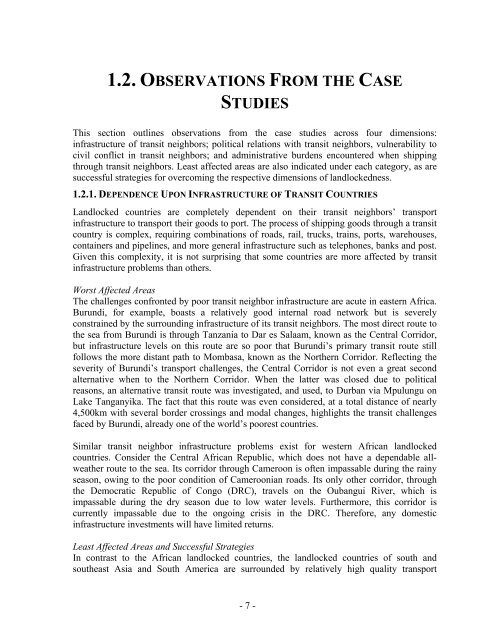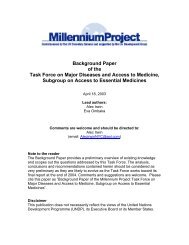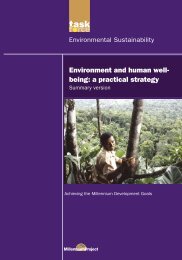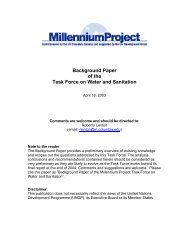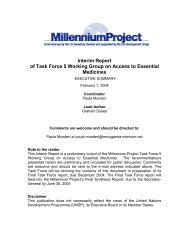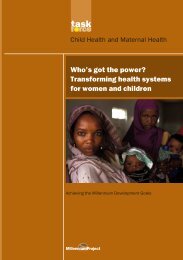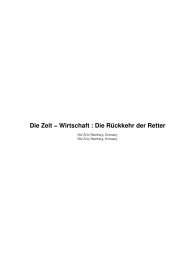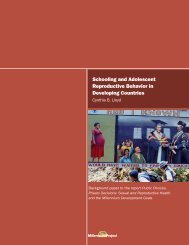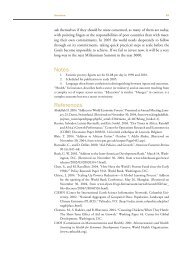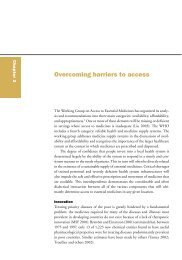the challenges facing landlocked developing countries: a case study ...
the challenges facing landlocked developing countries: a case study ...
the challenges facing landlocked developing countries: a case study ...
You also want an ePaper? Increase the reach of your titles
YUMPU automatically turns print PDFs into web optimized ePapers that Google loves.
1.2. OBSERVATIONS FROM THE CASE<br />
STUDIES<br />
This section outlines observations from <strong>the</strong> <strong>case</strong> studies across four dimensions:<br />
infrastructure of transit neighbors; political relations with transit neighbors, vulnerability to<br />
civil conflict in transit neighbors; and administrative burdens encountered when shipping<br />
through transit neighbors. Least affected areas are also indicated under each category, as are<br />
successful strategies for overcoming <strong>the</strong> respective dimensions of <strong>landlocked</strong>ness.<br />
1.2.1. DEPENDENCE UPON INFRASTRUCTURE OF TRANSIT COUNTRIES<br />
Landlocked <strong>countries</strong> are completely dependent on <strong>the</strong>ir transit neighbors’ transport<br />
infrastructure to transport <strong>the</strong>ir goods to port. The process of shipping goods through a transit<br />
country is complex, requiring combinations of roads, rail, trucks, trains, ports, warehouses,<br />
containers and pipelines, and more general infrastructure such as telephones, banks and post.<br />
Given this complexity, it is not surprising that some <strong>countries</strong> are more affected by transit<br />
infrastructure problems than o<strong>the</strong>rs.<br />
Worst Affected Areas<br />
The <strong>challenges</strong> confronted by poor transit neighbor infrastructure are acute in eastern Africa.<br />
Burundi, for example, boasts a relatively good internal road network but is severely<br />
constrained by <strong>the</strong> surrounding infrastructure of its transit neighbors. The most direct route to<br />
<strong>the</strong> sea from Burundi is through Tanzania to Dar es Salaam, known as <strong>the</strong> Central Corridor,<br />
but infrastructure levels on this route are so poor that Burundi’s primary transit route still<br />
follows <strong>the</strong> more distant path to Mombasa, known as <strong>the</strong> Nor<strong>the</strong>rn Corridor. Reflecting <strong>the</strong><br />
severity of Burundi’s transport <strong>challenges</strong>, <strong>the</strong> Central Corridor is not even a great second<br />
alternative when to <strong>the</strong> Nor<strong>the</strong>rn Corridor. When <strong>the</strong> latter was closed due to political<br />
reasons, an alternative transit route was investigated, and used, to Durban via Mpulungu on<br />
Lake Tanganyika. The fact that this route was even considered, at a total distance of nearly<br />
4,500km with several border crossings and modal changes, highlights <strong>the</strong> transit <strong>challenges</strong><br />
faced by Burundi, already one of <strong>the</strong> world’s poorest <strong>countries</strong>.<br />
Similar transit neighbor infrastructure problems exist for western African <strong>landlocked</strong><br />
<strong>countries</strong>. Consider <strong>the</strong> Central African Republic, which does not have a dependable allwea<strong>the</strong>r<br />
route to <strong>the</strong> sea. Its corridor through Cameroon is often impassable during <strong>the</strong> rainy<br />
season, owing to <strong>the</strong> poor condition of Cameroonian roads. Its only o<strong>the</strong>r corridor, through<br />
<strong>the</strong> Democratic Republic of Congo (DRC), travels on <strong>the</strong> Oubangui River, which is<br />
impassable during <strong>the</strong> dry season due to low water levels. Fur<strong>the</strong>rmore, this corridor is<br />
currently impassable due to <strong>the</strong> ongoing crisis in <strong>the</strong> DRC. Therefore, any domestic<br />
infrastructure investments will have limited returns.<br />
Least Affected Areas and Successful Strategies<br />
In contrast to <strong>the</strong> African <strong>landlocked</strong> <strong>countries</strong>, <strong>the</strong> <strong>landlocked</strong> <strong>countries</strong> of south and<br />
sou<strong>the</strong>ast Asia and South America are surrounded by relatively high quality transport<br />
- 7 -


